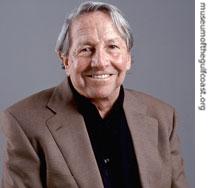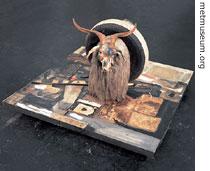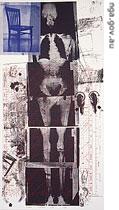VOA慢速英语-People in America - Robert Rauschenberg, 1925-2008:
时间:2019-01-11 作者:英语课 分类:VOA慢速英语2008年(六)月
He was also known for his many projects with other artists. Transcript 1 of radio broadcast:
07 June 2008
VOICE ONE:
I’m Steve Ember.
VOICE TWO:

Robert Rauschenberg
And I’m Faith Lapidus with People in America in VOA Special English. Today we tell about Robert Rauschenberg. He is widely considered one of the most influential 2 artists of the past half-century. Throughout his long career, Rauschenberg explored painting, sculpture, printmaking and even dance performance.
His inventive ideas and bold work made him a revolutionary presence in the art world. One art critic said that there has never been anything in American art to match the energy of Robert Rauschenberg’s imagination.
(MUSIC)
VOICE ONE:
He was born Milton Ernest Rauschenberg in nineteen twenty-five. He grew up in a Christian 3 religious family in the small town of Port Arthur, Texas. He studied pharmacology, the science of preparing and using medicine, at the University of Texas for a short time. But he did not complete his degree. He joined the Navy during World War Two in the nineteen forties and worked in hospitals in California. It was there that he saw paintings in an art museum for the first time. Though he had no training, Rauschenberg realized then that he wanted to be an artist.
After the war, he studied art at the Kansas City Art Institute as well as in Paris, France. Rauschenberg changed his first name to Robert because he thought it sounded more like the name of an artist. During this time, Rauschenberg met the artist Susan Weil. They later were married for two years and had a son.
VOICE TWO:
Rauschenberg continued his studies at Black Mountain College in North Carolina. There, he met a group of people who would help redefine modern art and performance. He became good friends with the dance choreographer 4 Merce Cunningham and the musician John Cage. He was also influenced by his teacher, the artist Josef Albers. Rauschenberg said that Albers was an impossible person. But he said Albers taught him how to develop his own personal sense of looking. And, this teacher urged students to explore many kinds of materials to make their art.
VOICE ONE:
In nineteen forty-nine, Rauschenberg moved to New York City to be part of its energetic art world. He made a series of all-white paintings. Then, he made a series of all-black paintings. He wanted to explore the way the paintings changed in different lighting 5 conditions, or as the shadow of a viewer passed in front of the work.
By the mid 6 nineteen fifties, Rauschenberg was making his first “combines," large works of art that were both paintings and sculptures. These experimental works broke down what usually were two very separate art forms. These works included objects such as boxes, books and radios that the artist found in the streets of New York.
The nineteen fifty-five combine called “Bed” became one of his most famous works. It includes a bed sheet, quilt and pillow covered in paint.
VOICE TWO:

''Monogram 7''
The thrown paint on “Bed” was similar to the work of Abstract Expressionist painters like Jackson Pollock who were active at the time. These abstract paintings were meant to show action and color instead of representing a subject matter. But Rauschenberg went beyond Abstract Expressionism by including objects from everyday life in his combines. Later, members of the Pop Art movement would further develop this inclusion of common objects. In nineteen fifty-nine, Rauschenberg made another famous combine, called “Monogram.” This work includes a dead goat with a rubber tire around its middle. The work stands on a painted surface with other "found" objects like part of a shoe and a tennis ball.
VOICE ONE:
Rauschenberg once said that he felt sorry for people who consider things like soap dishes, mirrors or Coke bottles to be ugly. He said these people must be very unhappy because they are surrounded by these objects all day long. Rauschenberg showed in his work that unexpected things can be beautiful if a person takes time to look.
(MUSIC)
VOICE TWO:
Over the years, Robert Rauschenberg continued exploring and combining different forms of art. He developed a method of drawing in which he covered printed images and words in chemicals, then transferred them onto paper using a pencil. He also made boldly inventive lithographs 9 that helped bring a new level of respect and attention to the art of printmaking.

''Booster''
In his nineteen sixty-four work called “Shade,” Rauschenberg combined bookmaking, printmaking and sculpture into one artwork. He printed black and white images onto plastic sheets, which could be placed like pages into a box. A light shining through the sheets made the work into a redefined version of a book. His nineteen sixty-seven print, “Booster,” was at the time the largest hand-pulled lithograph 8 ever made. Rauschenberg’s work broke down the boundaries between different artistic 10 methods.
VOICE ONE:
By the nineteen sixties, Rauschenberg had become famous in the art world. In nineteen sixty-four he became the first modern American to win the international grand prize at the Venice Biennale art show in Italy. But fame did not cause Rauschenberg to slow down his flow of new ideas. He worked on putting combinations of printed images onto large canvases using screen-printing.
He made many series of other prints, including a "Hoarfrost Series" in nineteen seventy-four. For these works, Rauschenberg printed images onto thin pieces of flowing silk and taffeta fabrics 11. And, in his "Cardboard Series," Rauschenberg created interesting wall sculptures using combinations of flattened 12 paper boxes.
Robert Rauschenberg once said that he worked in a direction until he knew how to do it, then he stopped. He said that once he became bored or he understood, another question had formed.
(MUSIC)
VOICE TWO:
Robert Rauschenberg strongly believed in working on projects with other artists. In the early nineteen fifties, he worked with his wife, Susan Weil. They made a series of large prints by shining a lamp over a person lying on special blueprint 13 paper. He also designed stage sets and costumes for dance productions by Merce Cunningham and other choreographers. He exchanged ideas and worked closely with the artist Jasper Johns. And, he worked with printing experts like Tatyana Grossman in her workshop, Universal Limited Art Editions, in New York.
VOICE ONE:
Rauschenberg helped start a nonprofit group called Experiments in Art and Technology with an engineer from Bell Telephone Laboratories. This group supported joint 14 projects by artists and scientists. The idea for the organization came out of a series of nine performances held in nineteen sixty-six in New York City. At these events, engineers and artists combined art and technology in experimental performances.
And, in nineteen eighty-five, he started ROCI which stands for Rauschenberg Overseas Cultural Interchange. Its aim was to find a way to communicate with other countries through the language of art.
Rauschenberg traveled to twenty-two countries including China, Tibet, Uzbekistan, Cuba and the Soviet 15 Union. He worked with artists in each country to create pieces of art. They were then exhibited in a museum in that country along with works made in other parts of the world. In nineteen ninety-one, the project ended at the National Gallery of Art in Washington, D.C. with an exhibit of art from each country.
VOICE TWO:
Robert Rauschenberg's work has been in many major museum exhibits. These include shows at the Pompidou Center in Paris, France in nineteen eighty-one and the Guggenheim Museum in New York in nineteen ninety-seven.
In two thousand five, the Metropolitan 16 Museum in New York opened an exhibit on Robert Rauschenberg’s combines. His work was also shown at the National Gallery in Washington in two thousand seven.
Later in his career, Rauschenberg started spending more and more time at his home on Captiva Island, off the coast of Florida. There, he had a large studio in which he could work on huge projects. In two thousand two, Rauschenberg suffered a stroke that left him unable to use his right side. He learned to work with his left hand. And, with the help of assistants, he kept making art.
Robert Rauschenberg died in two thousand eight at his home in Florida. He was eighty-two years old. His inventive examples of modern art will continue to influence future generations of artists and art lovers.
(MUSIC)
VOICE ONE:
This program was written and produced by Dana Demange. I’m Steve Ember.
VOICE TWO:
And I’m Faith Lapidus. You can see examples of Robert Rauschenberg's work at our Web site, voaspecialenglish.com. Join us again next week for People in America in VOA Special English.
- A transcript of the tapes was presented as evidence in court.一份录音带的文字本作为证据被呈交法庭。
- They wouldn't let me have a transcript of the interview.他们拒绝给我一份采访的文字整理稿。
- He always tries to get in with the most influential people.他总是试图巴结最有影响的人物。
- He is a very influential man in the government.他在政府中是个很有影响的人物。
- They always addressed each other by their Christian name.他们总是以教名互相称呼。
- His mother is a sincere Christian.他母亲是个虔诚的基督教徒。
- She is a leading professional belly dancer, choreographer, and teacher. 她既是杰出的专业肚皮舞演员,也是舞蹈设计者和老师。 来自辞典例句
- It'stands aside, my choreographer of grace, and blesses each finger and toe. 它站在一旁,我优雅的舞蹈指导,并祝福每个指尖与脚尖。 来自互联网
- The gas lamp gradually lost ground to electric lighting.煤气灯逐渐为电灯所代替。
- The lighting in that restaurant is soft and romantic.那个餐馆照明柔和而且浪漫。
- Our mid-term exam is pending.我们就要期中考试了。
- He switched over to teaching in mid-career.他在而立之年转入教学工作。
- There was a monogram in the corner in which were the initials"R.K.B.".原来手帕角上有个图案,其中包含着RKB三个字母。
- When we get married I don't have to change the monogram on my luggage.当我们结婚后,我连皮箱上的字母也不用改。
- Lithograph was introduced from China to Europe.印刷术是从中国传入欧洲的。
- Cole printed 1,000 of the cards on a lithograph stone before having them hand-colored.科尔随即用石版印刷了1000张,之后又让人给这些卡手工着色。
- The etchings, drypoints, lithographs, and engravings together formed his graphic work. 蚀刻画、铜版画、平版画以及雕刻构成了他书画刻印的作品。 来自互联网
- These historic works of art will be released as limited editions of signed lithographs. 这些艺术历史作品是以有限的单一的平版版本发行。 来自互联网
- The picture on this screen is a good artistic work.这屏风上的画是件很好的艺术品。
- These artistic handicrafts are very popular with foreign friends.外国朋友很喜欢这些美术工艺品。
- cotton fabrics and synthetics 棉织物与合成织物
- The fabrics are merchandised through a network of dealers. 通过经销网点销售纺织品。
- She flattened her nose and lips against the window. 她把鼻子和嘴唇紧贴着窗户。
- I flattened myself against the wall to let them pass. 我身体紧靠着墙让他们通过。
- All the machine parts on a blueprint must answer each other.设计图上所有的机器部件都应互相配合。
- The documents contain a blueprint for a nuclear device.文件内附有一张核装置的设计蓝图。
- I had a bad fall,which put my shoulder out of joint.我重重地摔了一跤,肩膀脫臼了。
- We wrote a letter in joint names.我们联名写了封信。
- Zhukov was a marshal of the former Soviet Union.朱可夫是前苏联的一位元帅。
- Germany began to attack the Soviet Union in 1941.德国在1941年开始进攻苏联。
- Metropolitan buildings become taller than ever.大城市的建筑变得比以前更高。
- Metropolitan residents are used to fast rhythm.大都市的居民习惯于快节奏。